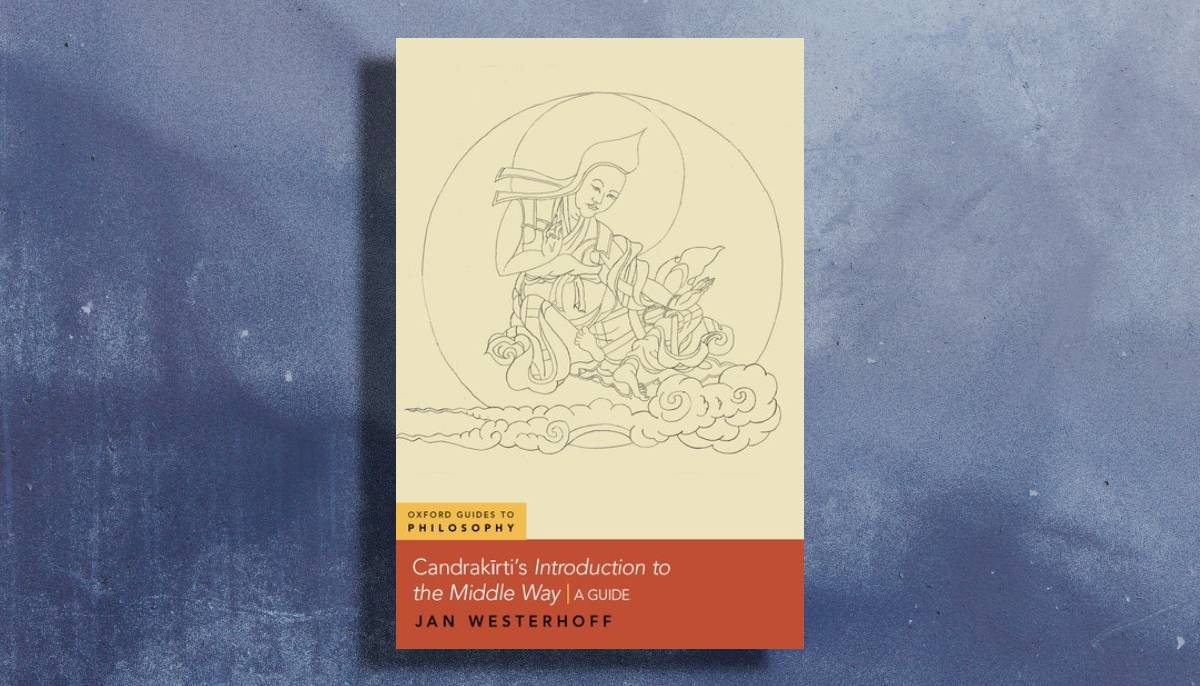Constance Kassor’s review from the Spring 2024 Buddhadharma:
In the Madhyamaka tradition of Mahayana Buddhism, Chandrakirti’s important seventh-century work Introduction to the Middle Way has achieved semicanonical status. This is an incredibly dense and occasionally cryptic work, and it requires a commentary in order to be understood in any detail. Many such commentaries have been written, both by Chandrakirti himself and by later Tibetan scholars. But Jan Westerhoff has made an important contribution to this commentarial tradition in Candrakīrti’s Introduction to the Middle Way: A Guide (Oxford). This commentary, like its Indian and Tibetan predecessors, is intended to be read alongside Chandrakirti’s root verses. It follows the structure of Chandrakirti’s writing, carefully explaining and contextualizing each verse. Westerhoff acknowledges that his own commentary is limited, focusing primarily on the philosophical aspects of the Introduction to the Middle Way, but this focus makes the commentary readable and understandable, even to readers without much prior knowledge of Buddhist philosophy or Madhyamaka. [Please note that the text from which this excerpt derives makes use of endnotes and diacritical; these are not represented in this excerpt.]
The Excerpt: “1. Preliminary remarks: Introducing Chandrakirti”
The translation of Chandrakirti’s name is “Glorious Moon,” and if we consider the historical context of Chandrakirti’s times it becomes apparent that he was indeed, like the moon, surrounded by lights in the star-studded firmament of asian intellectual and political history at the beginning of the 7th century. Living around the years 600–650 ce, his Indian contemporaries include Brahmagupta, who presented the first rules for the arithmetical manipulation of zero, as well as Dharmakirti, one of the most influential Indian Buddhist philosophers. Looking beyond India there is Songtsen Gampo, the founder of the Tibetan Empire, the second emperor of the Tang dynasty, Taizong, in China, the multi-talented King Amshuverma of Nepal, and the famous Buddhist scholar and traveler Xuanzang visiting India in the second quarter of the 7th century.
It is fair to say that Madhyamaka (together with Yogacara, the other main philosophical school of Mahayana Buddhism) was one of India’s most successful intellectual exports, and an understanding of Chandrakirti’s interpretation of Madhyamaka is essential for explaining how a large number of Madhyamaka philosophers subsequently understood this intellectual system. His work also constitutes a clear, comprehensive, and intellectually audacious introduction to central Madhyamaka ideas that provides its student with a well-appointed base camp for exploring other interpretations.
1a. Chandrakirti’s works
Chandrakirti’s extant works include four commentaries on key Madhyamaka texts: a detailed commentary on the foundational text of the Madhyamaka school, Nagarjuna’s Mulamadhyamakakarika called the “Clear Words” (Prasannapada), two commentaries on Nagarjuna’s shorter works, the “Seventy Verses on Emptiness” (Sunyatasaptati) and the “Sixty Stanzas on Reasoning” (Yuktisastika), and a commentary on aryadeva’s “Four Hundred Verses” (Catuhsataka). The most substantial among Chandrakirti’s independent works is the “Introduction to the Middle Way ” (Madhyamakavatara) which is the focus of our attention here. Chandrakirti also composed a detailed auto-commentary to this text, the Madhyamakavatarabhaṣya. Somewhat shorter independent works include the “Seventy Stanzas on the Three Refuges” (Trisaranasaptati), “a poetic introduction to lay-Buddhists from the viewpoint of the Mahayana”2 and the “Treatise on the Five aggregates” (Pancaskandhaprakarana), a discussion of Abhidharma ontology from the Madhyamaka perspective. Some of Chandrakirti’s works are still extant in the original Sanskrit, others are preserved in Tibetan translations. as befits the centrality of Chandrakirti’s thought for understanding Madhyamaka, his works have received a considerable amount of attention from Western scholars, and practically all of them have by now been translated into European languages.
1b. Chandrakirti’s life
We have little reliable information about Chandrakirti’s life. He was a Buddhist monk, possibly from South India, and belonged to the monastic university of Nalanda, at that time one of the greatest educational institutions in the world. There he specialized in teaching and commenting on Madhyamaka texts and eventually rose to the rank of Nalanda’s chancellor (kulapati), a position he might have held for a decade.
Some of the deeds ascribed to him in hagiographical accounts seem to be more befitting to a magician than to a monastic scholar; they include milking the picture of a cow in order to provide his fellow monks with food, animating a stone lion to scare away a hostile army, moving through walls, and throwing stone vessels without touching them.
It is worthwhile to note, though, that some of these events might play a double role in being both hagiographical transmutations of more mundane events in Chandrakirti’s life, and at the same time reflections of his philosophical outlook. Chandrakirti’s feeding the monks may be a narrative reworking of his success when being charged with the administration of Nalanda’s agricultural enterprises, supervising the farming and growing of crops that provided the food for an institution of considerable size. The military maneuvers with the stone lion could represent Chandrakirti’s skill in deflecting the threat from the Saivite Huna rulers persecuting Buddhists and attacking Buddhist monasteries.
These parts of Chandrakirti’s hagiography might also be taken as illustrations of his philosophical outlook, and in particular of the illusionism characteristic of Madhyamaka. If one accepts that there are no objective causal relations in the world, but that all causation only takes place at the level of conventional reality, which is a vast mind-made network of agreements between agents, one might be more inclined to accept that some particularly accomplished beings may be able to “tweak” the causal structure of the world so that milk flows from a picture, rather than from a real cow.
Chandrakirti’s biographies also contain various accounts of his interactions with the lay scholar and grammarian Candragomin, often presented as a proponent of Yogacara. These, too, might be a narrative representation of Chandrakirti’s highly critical stance to ward this rival school of Buddhist thought, a position that is amply demonstrated by the work we are about to discuss.
2. Looking backward: Nagarjuna and the Madhyamaka school
2a. Nagarjuna and Madhyamaka
The Madhyamaka school, of which Candrakīrti is one of the greatest exponents, is commonly regarded as founded in Nagarjuna’s (1st– 2nd ct ce) “Fundamental Verses on the Middle Way.” One should not assume, however, that Nagarjuna’s aim was to start a new philosophical school dedicated to the exposition of his own original ideas. Rather, his aim was to explain the original teaching of the historical Buddha, and to do so by particular emphasis on the “Perfection of Wisdom ” (Prajnaparamita) texts. Nagarjuna’s connection with these works forms a central part of his biography, and even of his name. One of the Prajnaparamita texts, the “Perfection of Wisdom in One Hundred Thousand Lines,” is said to have been given by Buddha Sakyamuni to a group of snake-spirits (the nagas) for safekeeping in their underwater kingdom. When the time was ripe, Nagarjuna descended to their realm and restored it to the human world.
2b. Commentators on the “Fundamental Verses on the Middle Way”
The “Fundamental Verses on the Middle Way” are a complex and dense work, and unsurprisingly gave rise to a series of commentaries trying to unlock their contents. The earliest Indian commentaries were composed by two Madhyamaka scholars, Buddhapalita13 (c. 470–540) and Bhaviveka (c. 500–570). A key difference between the interpretative approaches of Buddhapalita and Bhaviveka lies in the methodology they recommend for explaining Nagarjuna’s arguments, that is, in the way in which the Madhyamaka should defend his philosophical approach. Interestingly, this question turns out to be intricately connected with different opinions on the content of Madhyamaka, that is, with different views on what the Madhyamika is saying.
2c. The debate between Buddhapalita and Bhaviveka
According to Buddhapalita, Nagarjuna’s arguments should be spelled out by explicating the contradictory consequences of the positions Nagarjuna wants to reject. Bhaviveka, on the other hand, suggests that when Nagarjuna rejects a specific position we should explain this by providing an argument in accordance with the ancient Indian theory of inference that derives the negation of this position from a set of premises. Bhaviveka sees two advantages in this approach. First, it avoids that the student of Madhyamaka draws the wrong conclusion about what Nagarjuna wants to say. For example, if Nagarjuna’s rejection of entities being substantially produced from themselves is understood simply as deriving a contradiction from the claim that they are so produced, the opponent might mistakenly assume that Nagarjuna wants to assert the opposite, that entities are substantially produced from what is other than themselves. This misunderstanding can be avoided by explicitly presenting Nagarjuna’s position as a set of theses, including the position that entities are not substantially produced from themselves and are also not substantially produced from other entities. This then leads to the second advantage of Bhaviveka’s explicatory approach. If we set out Nagarjuna’s approach in terms of a set of worked-out arguments (instead of a series of contradictions drawn from positions one might hold) we will be able to present a set of theses (namely the conclusions of these arguments) that describe the core content of Madhyamaka as a philosophical position. If Madhyamaka is to be successful in debating other Buddhist and non-Buddhist schools it is advantageous to be able to say what the school’s position actually is, rather than letting it appear like a dialectical sniper who is quick to fire at contradictions arising from his opponent’s views, but never puts up a target of his own. This is precisely the place where a disagreement about how we should present Madhyamaka arguments morphs into one about what Madhyamaka is actually saying. Such a phenomenon is not one we encounter regularly. Two authors might disagree about how one should explain first-order predicate calculus to students (using a tableaux method or a natural deduction framework, say) but this disagreement will not turn into one about which formulae in first-order predicate calculus actually express valid inferences. In the case of Madhyamaka, however, we have a system that does not simply present a philosophical position, but also a view of the philosophical status of this position (and a view of the philosophical status of this view, and so on all the way up the hierarchy).17 This view might be regarded as a rejection of philosophical positions, in which case we see an obvious conflict with a result of Bhaviveka’s explicatory style, namely the provision of a set of theses that constitute the Madhyamaka position.
The Madhyamaka provides philosophical medicine to cure the existential suffering resulting from wrong views of reality. In doing so, he makes the contradictory consequences of these views explicit; he does not present his own views as rivals to combat them. It is Chandrakirti’s defense of Buddhapalita and criticism of Bhaviveka that launched the Prasaṅgika school. When we nowadays speak about Prasaṅgika Madhyamaka, we refer to a way of understanding Madhyamaka based on and developing Chandrakirti’s exposition of Nagarjuna, an exposition that takes itself to be grounded in Buddhapalita’s explanation of the “Fundamental Verses on the Middle Way.”
From Candrakīrti’s Introduction to the Middle Way: A Guide by Jan Westerhoff. Copyright © 2024 by Jan Westerhoff and published by Oxford University Press. All rights reserved. We thank Oxford University Press for providing this excerpt, and we thank our readers for supporting dharma publishers.
For more on the latest dharma books, read this issue’s edition of Buddhadharma on Books. Or see more excerpts and other digital exclusives for Buddhadharma readers here.

